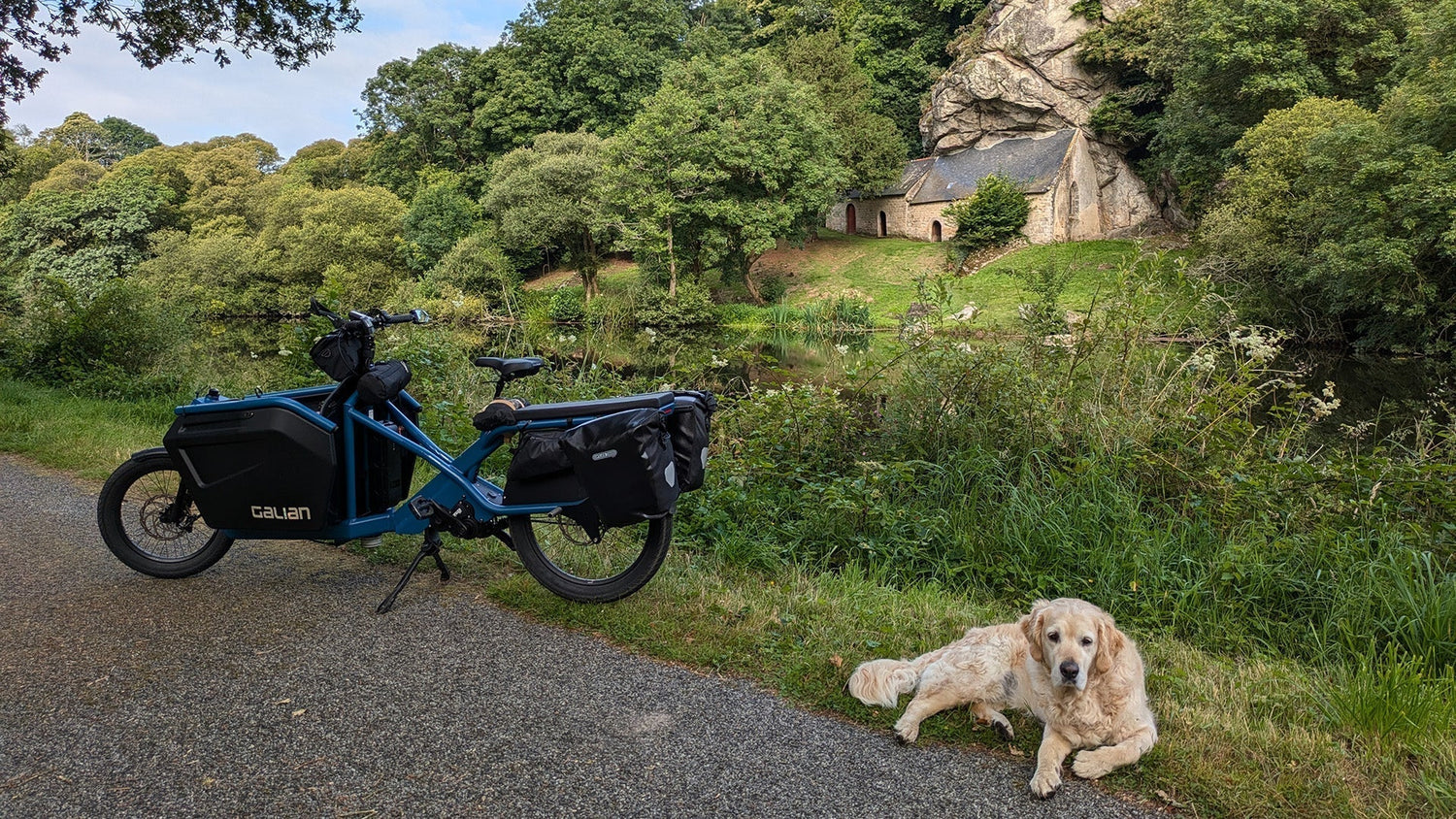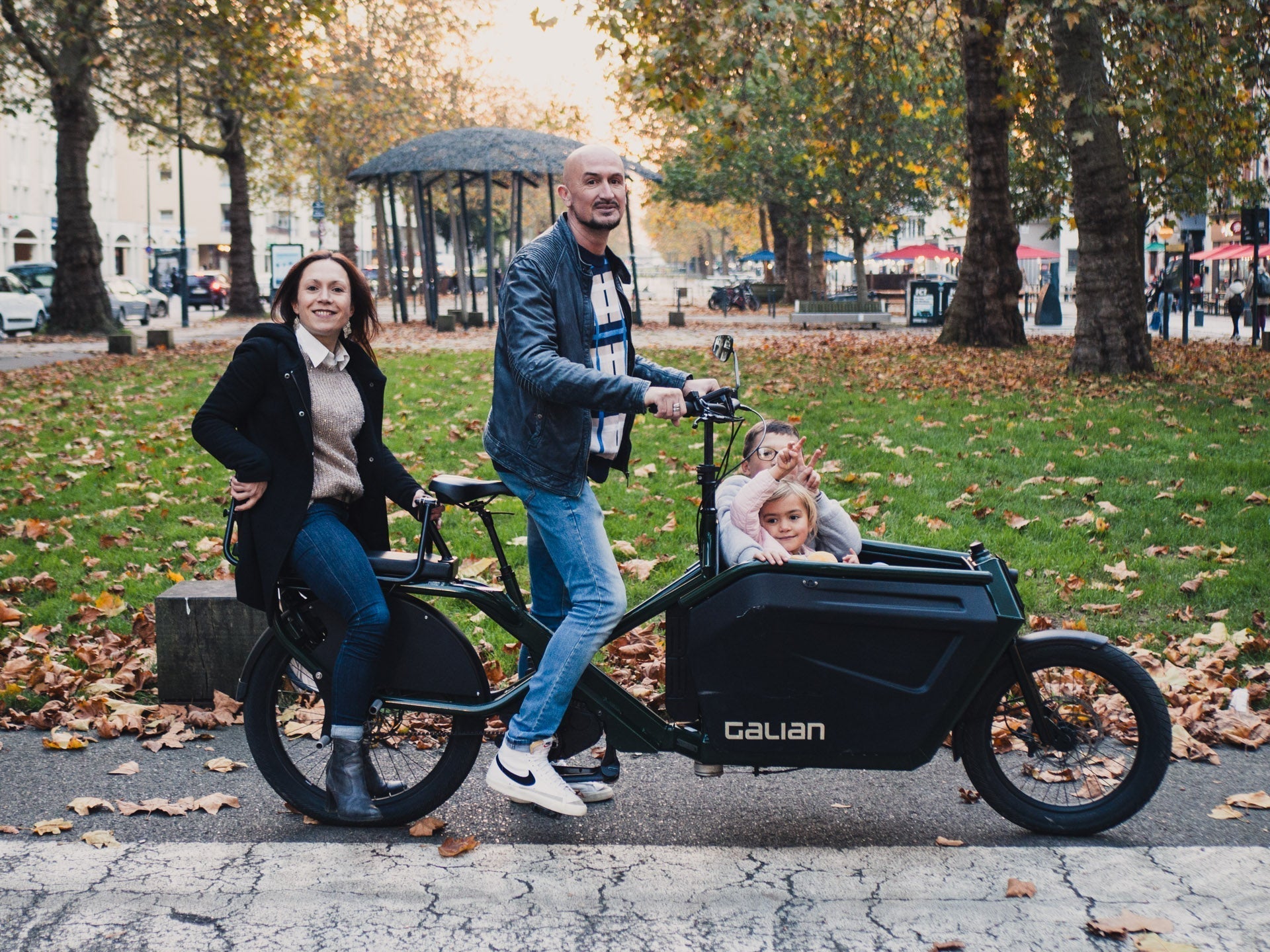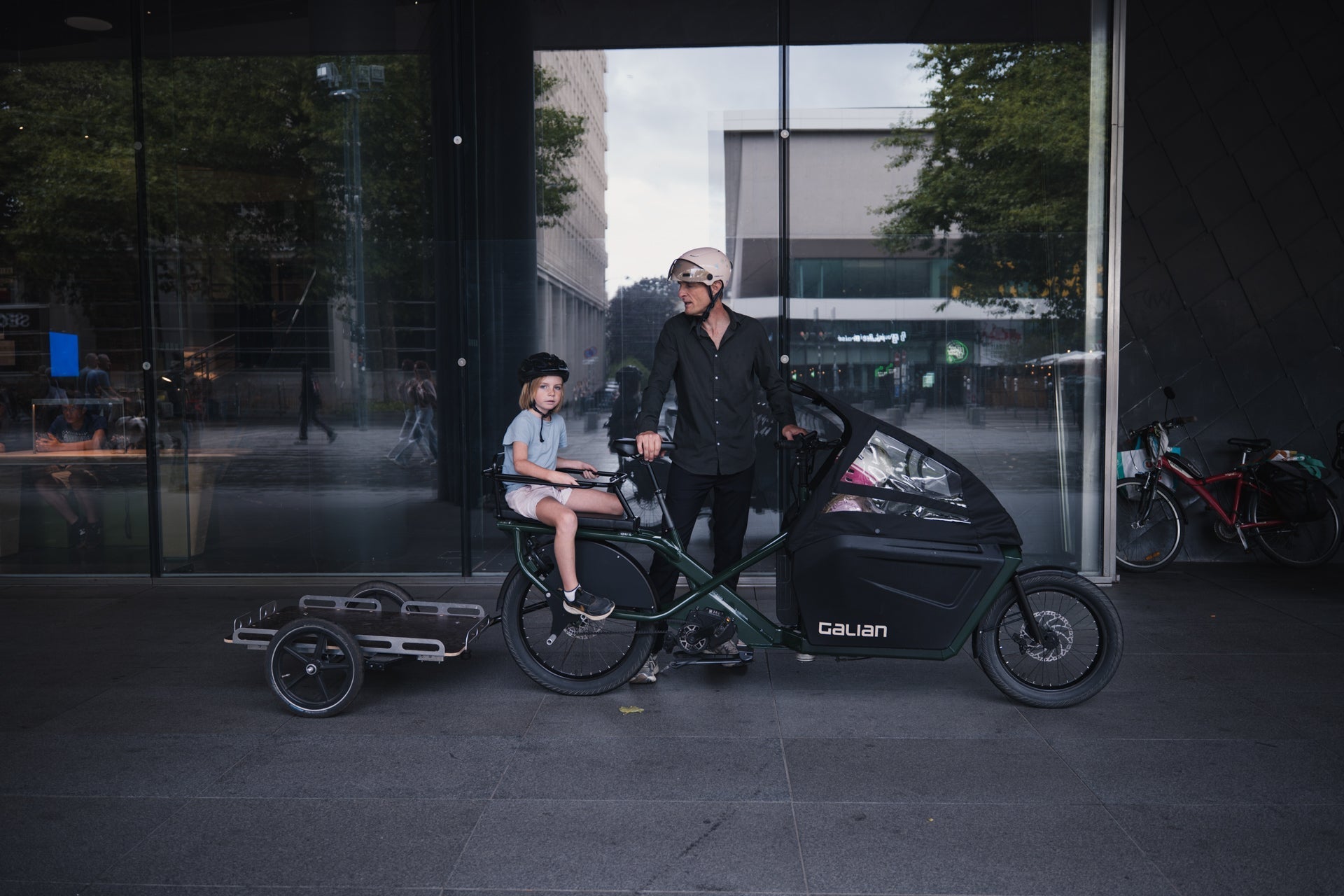While it seemed only suitable for urban commutes, the cargo bike is evolving. From the banks of the Loire to forest paths, this XXL bike is finding its place everywhere! In recent years, with the advent of electric bikes and the appearance of ever more powerful motors, riding an electric cargo bike in the mountains is even becoming an option!
So, is it possible to climb the Tourmalet loaded down like a mule? As long as you choose the right mount!
What type of cargo bike should you choose for mountain biking? What criteria should you use to make the right choice, and how can you differentiate between different types of bikes depending on their intended use (commuting, professional, or tourist use)? Galian can help you see things more clearly.
Cargo bikes in the mountains: what are the specific features?

As you might expect, riding a bike in the mountains (especially a cargo bike) is much more demanding than riding on flat terrain. Riding on hilly terrain has a few specific features that will influence your choice of cargo bike:
- The hills are significant: you have to climb hills, which depending on your route are more or less steep.
- The descents too: with sometimes wet roads (rain, leaves, snow) and winding roads, going downhill on a cargo bike can be technical.
- Weather conditions: depending on the altitude and where you are riding, rain, fog, wind, and even snow may occur.
- Road infrastructure: In mid- and high-altitude areas, roads are winding and sometimes narrow, which reduces the number of cycle paths. You must therefore share the road with cars and trucks.
- The terrain used: tarmac roads, paths or stony trails, depending on your route and your use, the terrain can be changeable.
-
Breathtaking landscapes: yes, cycling in the mountains also means having a clearer view. You'll be amazed! 🤩
What type of cargo bike should I choose?
When we talk about cargo bikes, we actually include many models:
- The longtail: it has an extended luggage rack at the rear. It allows you to accommodate children, adults, or several panniers to carry equipment.
- The cargo bike with a front trunk: this large box can accommodate your children, but also equipment in the case of a professional cargo bike.
This cargo bike has two or three wheels. We then speak of a two-wheeler or three-wheeler .
Now, let's talk about mountain travel. It really depends on your usage and the carrying capacity you need.
Keep in mind that riding in the mountains requires very good stability , especially when taking hairpin bends. A cargo bike with a box at the front has a lower center of gravity than a longtail. It is therefore more stable.
A tricycle can be a good option if you need to transport heavy loads (for example, for work). However, its large size can be a real obstacle when going uphill and downhill.
The cargo bike with a front box is a good compromise. Despite its bulk, it remains more maneuverable than a three-wheeler and offers good stability. It's ideal for your daily commute or your bike trip!
Last point, more than obvious (unless you have Pogačar's calves): electric assistance , which is present on most models, is essential!

How to choose your electric cargo bike in mountainous regions? 5 points to watch out for + bonus advice
1 - A powerful engine
To climb slopes of 4 to 10% on a cargo bike, electric assistance is therefore more than necessary. And for that, nothing beats a powerful motor.
How do you assess the power of an electric bike motor? It all comes down to three factors:
- The power of the motor , which is expressed in Watts (W). In France, the majority of models have a 250 W motor. Beyond this, an electric bicycle belongs to the moped class.
- Engine torque is expressed in Newton meters (Nm). From 40 Nm for the least powerful electric bikes to over 130 Nm for the most powerful, you have the choice.
- The type of motor that can be located on the rear or front wheel hub or in the bottom bracket.
So what do we advise you?
If you live in a hilly city with an average 5% gradient, 80 to 90 Nm of torque may be sufficient. For hauling heavy loads in a mountainous area, opt for a torque greater than 90 Nm .
As for its location, we recommend a motor located in the bottom bracket . It offers better stability and maneuverability to the cargo bike. Since it is directly connected to the transmission, the electric assistance adapts to the force you exert on the pedals. This makes pedaling more natural and progressive.
💡 Focus on hill start assist
All cargo bike engines assist with hill starts, but not in the same way or with the same efficiency. Getting started on the fly when riding a cargo bike isn't always easy, especially when the slope is steep.
To overcome this difficulty, some engine models, such as the Valeo Cyclee featured on our Le Formidable cargo bike, deliver the right torque for starting depending on the slope. You can easily start, even when fully loaded!
2 - A high-performance battery

Battery capacity (expressed in Wh) is an important point to check, especially if your route is hilly. Indeed, a loaded cargo bike will require more use of electric assistance. Therefore, the higher the battery capacity, the greater the theoretical autonomy (the number of kilometers ridden) will be.
In the mountains, starts, hills and sometimes harsh weather conditions tend to reduce this theoretical autonomy. Consequently, choosing a battery with high capacity (more than 600 Wh) is recommended.
Whether you're a professional or a cycle tourist, your journeys are long and you're afraid of running out of battery? In this case, don't take any risks and keep a second battery with you to extend the range of your cargo bike.
💡 Also read: in this article, discover our tips for optimizing the range of your electric bike .
3 - Suitable tires
After the engine, focus on the durability of the tires . You'll be carrying heavy loads over hilly terrain. You may have to ride in the rain, snow, or fog. Sometimes you'll even have to take stony paths. Choosing a cargo bike with tires that are suitable for your use is therefore essential.
For good riding comfort and better resistance to heavy loads, start by looking at the tire width. For a cargo bike, a tire at least 60 mm wide is recommended. Tires wider than 75 mm are reserved for mountain bikes.
In the mountains, good grip is essential, especially in winter. Tires with side studs guarantee good grip when cornering and on wet roads.
4 - Reinforced brakes
Want to safely ride your cargo bike down hills? Then good brakes are essential. When fully loaded, controlling your descent is essential.
On today's cargo bikes, the majority have mechanical disc brakes (mid-range models) or hydraulic disc brakes (high-end models). The advantage of the latter? Hydraulic disc brakes respond very well, even under heavy loads.
💡 Good to know: For even more efficient braking, especially on descents, you can also control the number of pistons. This varies from 2 to 4 pistons depending on the model. For example, our Formidable cargo bike has 4-piston brake discs (compared to 2 on most e-bikes), which ensures excellent braking, even when the bike is loaded.
5 - Good lighting
If you live in the mountains, you know: the weather is very changeable. When riding at night, in foggy or rainy weather, powerful and smart lighting is essential. You can see better and be more visible, thus increasing your safety.
Here are the points you can check before your purchase:
- The luminous flux of the bicycle lamp (number of lumens - lm) : outside built-up areas, opt for a front light of at least 300 lm and a rear light of at least 100 lm. In the city, if the streets are lit, a front light of 20 to 100 lm and a rear light of 10 to 20 lm are suitable.
- Lighting intensity: for mixed journeys, in built-up areas and outside built-up areas, some models allow you to vary the light intensity (“full beam” or “position lights”).
- Two types of headlights (fixed and directional): practical if you take winding roads or paths.
💡 Learn more: Night cycling, pedal safely
Our bonus tip: regular maintenance and cleaning
Regular maintenance of an electric cargo bike is essential to ensure the longevity of the mechanical and electronic parts.
If you use your cargo bike daily in the mountains, this maintenance is even more important. Your rides are hilly, so you rely more on your brakes and electric assistance. Your tires are also put under a lot of strain.
For daily use of your cargo bike, be sure to perform two service visits per year. Also remember to clean the frame and wheels frequently. Mud and dust can damage your bike over time.
Bike commuting, professional or tourist use: each use has its own needs
Whether you're commuting, working, or touring, the key points to consider when choosing your cargo bike are the same. However, depending on how you plan to use it, certain criteria will apply.
| Use | Key points to check before purchase |
| Bike commuting in urban areas |
|
| Professional use (deliveries in urban areas) |
|
| Cycle tourism (outside built-up areas, paths and roads) |
|
As you can see, riding a cargo bike in the mountains is possible . Of course, your intended use and your journeys will determine your purchase.
Given the constraints linked to the terrain and the weather, we advise you to opt for a cargo bike with robust and efficient electronic and mechanical components . This guarantees your safety while enjoying cycling on hilly terrain.
One last piece of advice before you start choosing a model: test it in real conditions or ask a professional for advice. After that, nothing will stop you!



Leave a comment
This site is protected by hCaptcha and the hCaptcha Privacy Policy and Terms of Service apply.